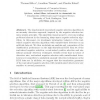Free Online Productivity Tools
i2Speak
i2Symbol
i2OCR
iTex2Img
iWeb2Print
iWeb2Shot
i2Type
iPdf2Split
iPdf2Merge
i2Bopomofo
i2Arabic
i2Style
i2Image
i2PDF
iLatex2Rtf
Sci2ools
ICARIS
2005
Springer
2005
Springer
A Comparative Study of Real-Valued Negative Selection to Statistical Anomaly Detection Techniques
The (randomized) real-valued negative selection algorithm is an anomaly detection approach, inspired by the negative selection immune system principle. The algorithm was proposed to overcome scaling problems inherent in the hamming shape-space negative selection algorithm. In this paper, we investigate termination behavior of the realvalued negative selection algorithm with variable-sized detectors on an artificial data set. We then undertake an analysis and comparison of the classification performance on the high-dimensional KDD data set of the real-valued negative selection, a real-valued positive selection and statistical anomaly detection techniques. Results reveal that in terms of detection rate, real-valued negative selection with variable-sized detectors is not competitive to statistical anomaly detection techniques on the KDD data set. In addition, we suggest that the termination guarantee of the real-valued negative selection with variable-sized detectors is very sensitive t...
Related Content
| Added | 27 Jun 2010 |
| Updated | 27 Jun 2010 |
| Type | Conference |
| Year | 2005 |
| Where | ICARIS |
| Authors | Thomas Stibor, Jonathan Timmis, Claudia Eckert |
Comments (0)

